- 7 Top Flite Golf Clubs XL for Improved Performance - September 28, 2024
- Top Flite Golf Clubs: Top 5 Reasons to Choose Them - September 28, 2024
- Top 3 Golf Club Fitters for a Perfect Swing - September 28, 2024
When looking for a forgiving golf club, you'll want one that minimizes distance loss and improves accuracy on off-center hits. To achieve this, forgiving clubs typically feature a larger sweet spot, especially in cavity back designs, and a lower center of gravity to promote higher launch angles. Perimeter weighting and advanced materials like hollow body designs also contribute to increased ball speed and stability. By understanding these design features and characteristics, you'll be better equipped to select the right club for your game. As you explore further, you'll uncover more nuances that can help you optimize your performance.
Key Takeaways
- A larger sweet spot, often achieved through cavity back designs, minimizes distance loss and improves accuracy on off-center hits.
- Perimeter weighting and strategically distributed weight promote stability and forgiveness, reducing the effects of poor swings.
- A lower center of gravity facilitates higher launch angles, resulting in better ball flight and increased distance.
- Lightweight graphite shafts enable faster swing speeds, increasing power and distance, especially for slower swing speeds.
Defining Forgiving Golf Clubs
When you step into the golf equipment market, you're likely to come across the term 'forgiving golf clubs.' But what exactly does it mean, and how do these clubs differ from their less forgiving counterparts?
Forgiving golf clubs are designed to minimize distance loss and improve accuracy on off-center hits by maintaining ball speed and reducing dispersion. This is achieved through clever design features that guarantee a larger sweet spot, allowing for better performance on mishits. Cavity back designs, in particular, offer a larger sweet spot, making them a popular choice for those seeking forgiveness.
The key to forgiveness lies in the club's center of gravity (c.g.) location, which affects the club's stability and launch potential. A well-designed forgiving club will have a strategically placed c.g., resulting in a more consistent ball flight.
Additionally, features like larger club heads and wider soles contribute to a club's forgiveness. By understanding what makes a forgiving golf club, you'll be better equipped to find the right clubs that match your swing characteristics, leading to more consistent and improved results on the course.
Target Audience for Forgiveness
As you explore the benefits of forgiving golf clubs, it's natural to wonder who can gain the most from these design features, and the answer lies in the skill levels and swing characteristics of different golfers.
| Skill Level | Swing Characteristics | Benefit from Forgiving Clubs |
|---|---|---|
| Beginner/Intermediate | High handicaps, imperfect swings | High |
| Experienced | Low handicaps, refined swing mechanics | Low |
| All | Personal comfort, feel, and confidence | High |
Forgiving clubs are particularly suited for beginners and intermediate players with high handicaps, as they help improve accuracy and distance despite imperfect swings. The design features that contribute to forgiveness, such as larger club heads and lightweight materials, make these clubs more accessible and enjoyable for players still developing their skills. While experienced golfers may not benefit as much from forgiving clubs due to their refined swing mechanics, personal comfort and the feel of the clubs are essential for all players, as they enhance confidence and overall enjoyment of the game, regardless of skill level. Forgiving clubs, often marketed as game improvement tools, can extend their benefits to any golfer looking to enhance consistency and performance, making them valuable across various skill levels, particularly when it comes to improving ball flight.
Selecting the Right Clubs
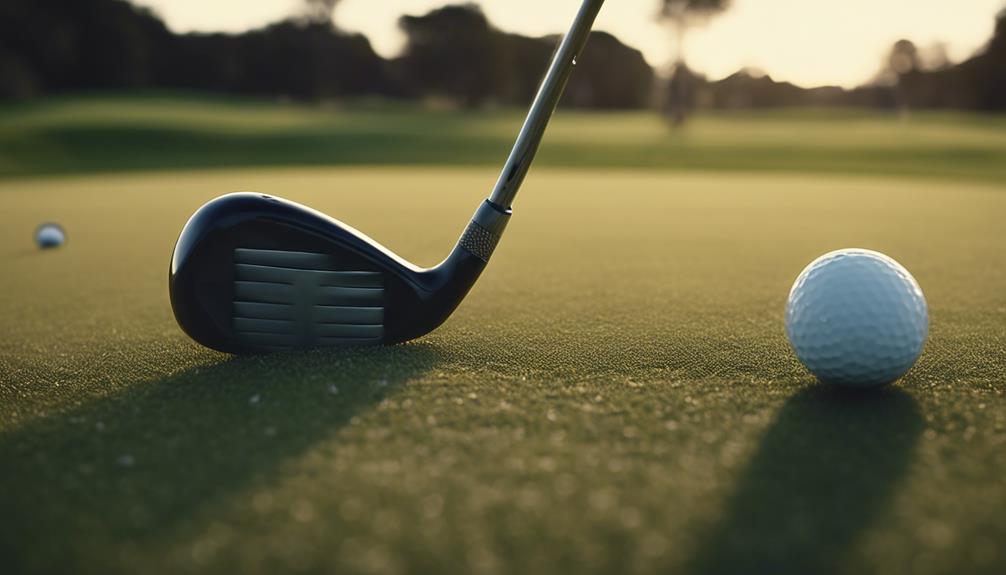
To access the full potential of forgiving golf clubs, you must carefully select models that cater to your unique needs and swing characteristics.
When choosing forgiving clubs, prioritize those with larger club heads and balanced weight distribution, as these features enhance stability and reduce the effects of poor swings.
Look for cavity back designs, which typically offer larger sweet spots and better performance on off-center hits, making them ideal for players seeking forgiveness.
Consider the loft of the clubs; a loft between 10 to 12 degrees in drivers can optimize height and distance, while forgiving irons often feature weaker lofts to promote easier launch angles.
Don't forget to test different shafts, as lightweight graphite options can facilitate faster swings and increase distance, contributing to the overall forgiveness of the clubs.
Finally, make sure to assess personal comfort and feel when trying out clubs, as individual preferences can greatly impact performance and enjoyment on the course.
Forgiving Driver Characteristics
You'll find that forgiving drivers are engineered with specific characteristics that help you achieve consistent results, even on off-center hits. These characteristics are designed to counteract the imperfections in your swing, ensuring that your drives fly straight and far.
Some key features of forgiving drivers include:
- A loft between 10 to 12 degrees, which helps achieve ideal height and distance.
- Lightweight graphite shafts, enabling faster swing speeds that contribute to increased power and distance.
Additionally, forgiving drivers often feature a larger club head and perimeter weighting, which expands the sweet spot and minimizes the effects of poor contact. This means that even if you don't hit the ball exactly in the center, the club will still produce a decent shot.
Pairing a forgiving driver with low spin golf balls can further enhance overall performance by improving distance and accuracy on mis-hits. By understanding these characteristics, you can choose a forgiving driver that suits your game and helps you achieve mastery on the course.
Forgiving Irons and Wedges
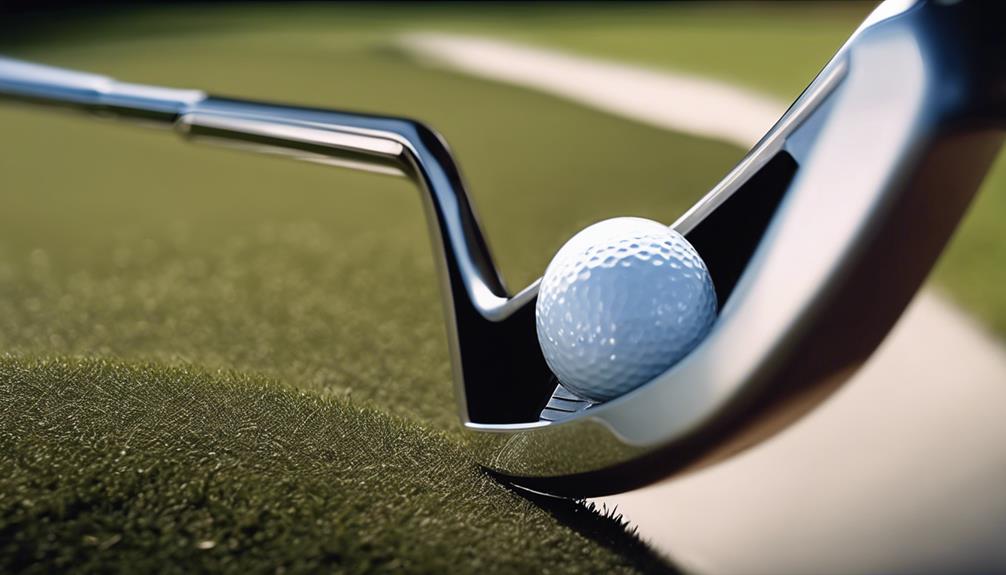
When you're looking for a forgiving iron or wedge, you'll want to pay attention to the cavity back design, clubhead shape, and weight distribution.
These key features will impact your game by providing a larger sweet spot, improved launch angles, and better turf interaction.
Cavity Back Design
By incorporating a cavity back design, forgiving golf clubs feature a larger sweet spot, which markedly reduces distance loss on off-center hits and promotes more consistent contact. This design innovation is particularly beneficial in forgiving irons, where a larger sweet spot can mean the difference between a great shot and a mediocre one.
Here are some key advantages of cavity back designs:
- Wider soles for better turf interaction: The wider soles of cavity back irons and wedges help you maintain accuracy and minimize mishits during swings.
- Lower center of gravity for higher launch angles: A lower center of gravity in cavity back clubs makes it easier to get the ball airborne, resulting in higher launch angles.
Clubhead Shape Matters
The clubhead shape of forgiving irons and wedges plays a critical role in enhancing forgiveness, as its larger profile and strategically distributed weight work together to promote solid contact and minimize the impact of mishits.
When you swing a forgiving club, the expanded sweet spot increases your chances of making solid contact, even on off-center hits. The cavity back design in these clubs distributes weight around the perimeter, providing increased stability and reducing the impact of mishits on ball flight and distance.
A lower center of gravity in the clubhead shape also helps launch the ball higher, making it easier for you to achieve ideal ball flight and distance. Additionally, wider soles on forgiving irons and wedges improve turf interaction, reducing the chances of digging into the ground or bouncing on poor swings.
Weight Distribution Impact
In forgiving irons and wedges, strategically distributed weight plays an essential role in maximizing forgiveness. This design feature enables you to achieve more consistent results even on off-center hits. By cleverly positioning weight in the clubhead, manufacturers can lower the center of gravity, making it easier for you to launch the ball higher and achieve better overall performance.
Here are some key aspects of weight distribution in forgiving irons and wedges:
Lowered center of gravity: Weight distribution helps to reduce the center of gravity, resulting in higher launch angles and improved ball flight.
Perimeter weighting: Cavity back designs often feature perimeter weighting, which enhances the club's stability on off-center hits, providing a larger sweet spot for better forgiveness.
Even weight distribution: A wider sole design helps distribute weight evenly across the clubhead, improving turf interaction and preventing digging into the ground during swings.
Club Design and Forgiveness
You'll find that forgiving golf clubs owe their reputation to innovative design elements that work together to produce consistent results, even when you don't quite hit the ball squarely.
The club design itself plays a significant role in forgiveness, with features like larger club heads expanding the sweet spot for more effective strikes on off-center hits.
The lower center of gravity (c.g.) in cavity back irons promotes higher launch angles and greater distance for players with varying swing abilities.
Weight distribution in forgiving clubs is often concentrated at the perimeter, minimizing the effects of poor swings and enhancing overall stability during impact.
Wider soles and thicker top lines aid in turf interaction and facilitate easier launches for higher trajectories.
Advanced materials and construction techniques, such as hollow body designs, contribute to increased ball speed and reduced spin rates, improving performance on mishits.
Performance Comparison: Cavity Backs Vs Blades
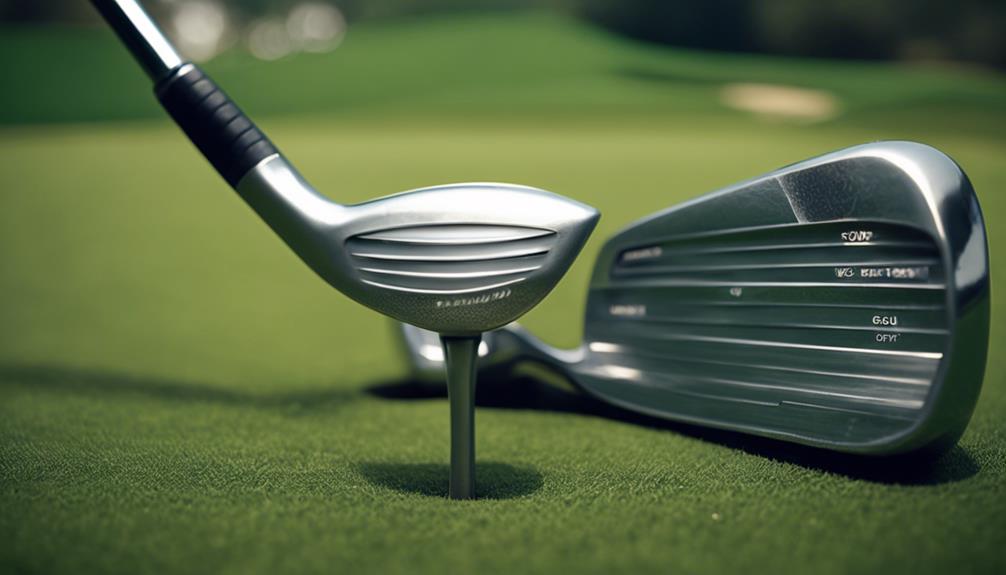
As you explore the world of forgiving golf clubs, you're likely wondering how cavity backs and blades stack up regarding performance.
When it comes to cavity back irons, you'll find they generally offer a larger sweet spot and more perimeter weighting, resulting in better distance and accuracy on off-center hits.
Now, let's compare this to blade irons, which are designed for skilled players and provide a tighter dispersion on well-struck shots, but often come at the cost of distance loss on mishits.
Cavity Back Performance
When comparing cavity back irons to blades, one key difference stands out: cavity backs offer a larger sweet spot and better mass distribution, allowing you to achieve more consistent performance even on off-center hits. This design feature makes cavity backs more forgiving, as they can minimize distance loss when the ball is struck poorly.
Here are some key benefits of cavity back irons:
- They produce more reliable results for high-handicap players, as they're more consistent and forgiving.
- They excel in minimizing distance loss on mishits, making them a great option for golfers with varying swing skills.
In practical tests, cavity back irons have demonstrated improved overall consistency and distance retention on mishits compared to traditional blade designs. This makes them an excellent choice for golfers seeking a more forgiving club that can help improve their game.
Blade Design Comparison
By comparing the design features and performance characteristics of cavity back irons and blades, golfers can gain a deeper understanding of which club type best suits their individual needs and skill levels.
When it comes to forgiveness, cavity back irons have a clear advantage. Their larger sweet spot and perimeter weighting provide more forgiveness on off-center hits, making them a great option for golfers of all skill levels. In contrast, blades have a smaller sweet spot and require precise contact for peak performance, making them less forgiving overall.
Here's a breakdown of the key differences between cavity back irons and blades:
| Cavity Back Irons | Blades | Forgiving Characteristics | |
|---|---|---|---|
| Sweet Spot | Larger | Smaller | More forgiving on off-center hits |
| Center of Gravity | Lower | Higher | Promotes higher launch angles and better distance |
| Performance on Mishits | More consistent | Less consistent | Provides more reliable results |
While blades may offer tighter dispersion on well-struck shots, their lack of forgiveness makes them a less appealing option for most golfers. If you're looking for a club that will help you improve your game, cavity back irons are definitely worth considering.
Design Features Impacting Forgiveness
You'll notice that forgiving golf clubs typically boast larger club heads, which increase the sweet spot and help maintain distance and accuracy on off-center hits. This design element is essential in enhancing forgiveness, as it provides a bigger area for you to make solid contact with the ball.
When examining forgiving golf clubs, you'll find that certain design features contribute to their overall forgiveness. Some key design elements include:
- Perimeter-weighted clubs: Mass distribution at the perimeter minimizes the effects of poor swings and enhances stability during impact.
- Cavity back designs: A lower center of gravity aids in launching the ball higher and more consistently.
These design features, among others, work together to create a forgiving club face that helps you achieve consistent results, even on mis-hits.
Marketing Influence and Perception
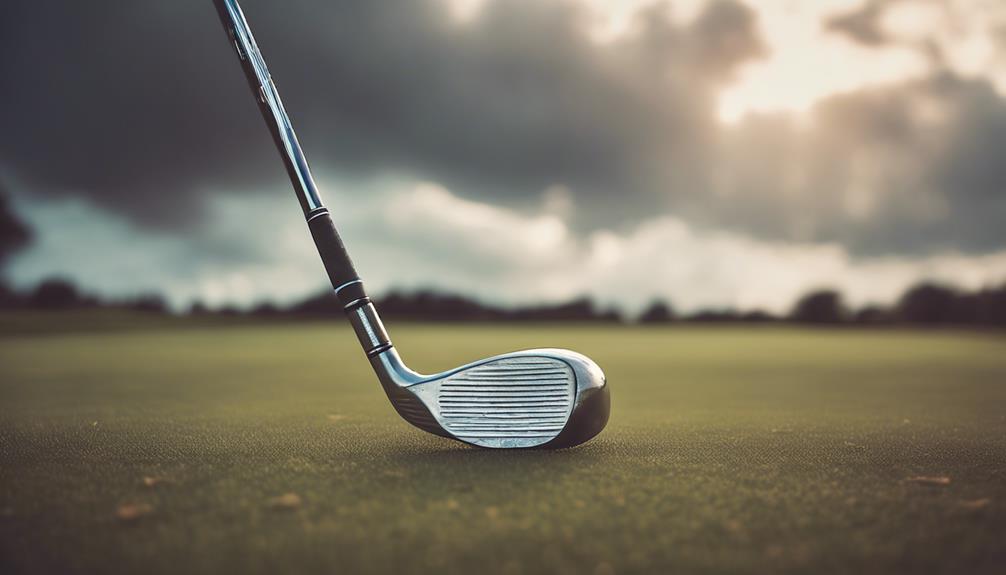
Many golfers are led to believe that forgiving golf clubs will drastically improve their game, thanks to marketing campaigns that often blur the lines between reality and hype.
You may associate forgiveness with features like larger club heads and advanced materials, but this perception can be influenced by marketing campaigns emphasizing distance and ease of use.
Be cautious, as marketing often exaggerates the benefits of forgiving clubs, creating confirmation bias among consumers who may overlook the importance of swing mechanics over equipment.
Professional endorsements and testimonials play a significant role in shaping your perceptions of forgiving clubs, leading to an increased belief in their effectiveness without substantial testing.
As a result, skepticism exists within the golfing community regarding the tangible differences between forgiving and non-forgiving clubs, as personal experiences often take precedence over marketing claims.
It's crucial to separate fact from fiction and critically evaluate the claims made by manufacturers to make informed decisions about your equipment.
Technology and Personal Experience
As you explore the world of forgiving golf clubs, you'll notice that advances in club design play a significant role in enhancing forgiveness.
By incorporating features like perimeter weighting and low center of gravity, these clubs increase the sweet spot and maintain ball speed on off-center hits.
Your personal experience with these clubs will ultimately depend on how well they suit your individual swing mechanics, which is why real-world testing is essential to finding the right fit.
Advances in Club Design
What role do advances in club design play in enhancing forgiveness and overall performance in golf clubs? As you explore the latest innovations, you'll discover that club design advancements have markedly improved forgiveness and overall performance.
Here are some key developments that contribute to this enhancement:
- Lightweight graphite shafts allow you to achieve faster swing speeds and increased distance without sacrificing control.
- Cavity back designs in forgiving clubs expand the sweet spot, redistributing weight around the perimeter of the club head to improve performance on off-center hits.
These advancements have led to notable improvements in shot consistency and accuracy, particularly for golfers with less refined swing mechanics.
By incorporating high-strength steel, composite structures, and other advanced materials, club designers have been able to optimize energy transfer at impact, resulting in higher ball speeds and reduced distance loss on mishits.
As you consider upgrading to a more forgiving club, remember that advances in club design can make a substantial difference in your game.
Personal Forgiveness Experience
By experiencing the benefits of forgiving golf clubs firsthand, you'll likely discover that the right club head design and advanced technologies can greatly improve your overall performance and confidence on the course.
You'll notice that cavity backs, for instance, provide a larger sweet spot, resulting in better performance on off-center hits. Advanced technologies like weight distribution and face technology also play an important role in enhancing forgiveness, maintaining ball speed, and reducing dispersion even when contact is less than perfect.
Many golfers report that forgiving clubs, such as those with hybrid-style technology, make it easier to launch the ball, contributing to greater distance and accuracy.
However, it's vital to recognize that personal swing mechanics remain a critical factor in overall success on the course. As you experiment with different forgiving clubs, you'll come to appreciate how they can compensate for your unique swing characteristics and mishits.
Real-World Testing Matters
When evaluating forgiving golf clubs, you'll want to put them to the test under real-world conditions, where the nuances of your swing and the club's technology intersect. This is where real-world testing matters.
It's one thing to read about a club's forgiveness in theory, but it's entirely different to experience it firsthand on the course. Real-world testing involves measuring performance under typical playing conditions, allowing you to evaluate how clubs respond to your unique swing flaws.
This type of testing can include:
- Independent evaluations using launch monitors to measure ball speed, launch angle, and spin rates
- Feedback from actual players during outdoor testing to reveal how forgiving clubs perform on mishits
Club Features for Easier Play
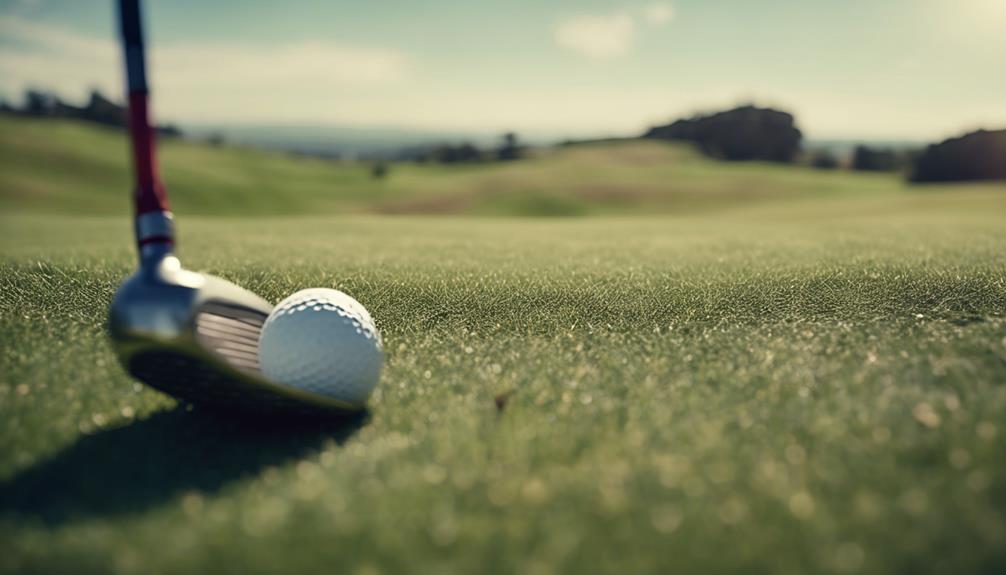
Featuring larger club heads and perimeter weighting, forgiving golf clubs are designed to minimize the effects of off-center hits and provide a larger sweet spot for better contact. These design elements enable you to achieve more consistent results, even when you don't hit the ball directly in the center of the club face.
As you explore forgiving golf clubs, you'll notice that many feature cavity back designs, which distribute mass away from the center, enhancing stability and reducing distance loss on mishits. Additionally, lightweight graphite shafts are often used to facilitate faster swing speeds, leading to improved ball distance and height.
| Feature | Benefit | Advantage |
|---|---|---|
| Larger Club Head | Increased Sweet Spot | More Consistent Results |
| Perimeter Weighting | Reduced Distance Loss | Improved Accuracy |
| Cavity Back Design | Enhanced Stability | Better Mishit Performance |
Understanding Dispersion and Distance
You'll quickly notice that forgiving golf clubs are designed to tackle two critical aspects of your game: dispersion and distance, with innovative designs and technologies working in tandem to minimize the spread of shots and maximize ball travel.
Dispersion refers to the spread of shots around a target, and forgiving clubs are engineered to keep this spread tight, even on off-center hits. This means you'll see more consistent shot patterns, even with imperfect swings.
When it comes to distance, forgiving clubs are designed to optimize ball speed and reduce distance loss on mishits. Here are a few key ways they achieve this:
- A lower center of gravity (c.g.) contributes to higher launch angles and increased distance, particularly for players with slower swing speeds.
- Advanced materials and technologies, such as face flexing systems, help generate ball speed across a larger area of the clubface.
Frequently Asked Questions
How to Tell if a Golf Club Is Forgiving?
You can determine if a golf club is forgiving by analyzing its design features, such as size and weight distribution, and testing its performance with swing mechanics analysis, considering how player skill impact affects its forgiveness.
What Is a Forgiving Golf Club?
You'll benefit from a forgiving golf club, which incorporates clever club design to compensate for swing mechanics imperfections, boosting player confidence through consistent performance, even on off-center hits, resulting in improved overall gameplay.
What Does It Mean if a Driver Is Forgiving?
When you wield a forgiving driver, it's like having a safety net – it's designed to rescue your imperfect swings. With innovative driver design features, impact technology innovation, and swing speed compatibility, you'll experience more consistent performance and improved accuracy, even on off-center hits.
What Are the Most Forgiving Golf Clubs for Seniors?
When shopping for forgiving golf clubs as a senior, you'll benefit from models featuring lightweight materials, oversized clubheads, and designs tailored to your swing speed, such as the Ping G430 and Wilson Dynapower, which offer exceptional distance and accuracy.
Conclusion
As you step onto the green, remember that a forgiving golf club is like a trusted navigator – it helps you stay on course even when you veer off.
Just like how a GPS recalibrates after a wrong turn, a forgiving club adjusts to your imperfections, guiding the ball back to its intended path.
With the right club in hand, you'll find that even the slightest miscalculation won't send your game into a tailspin, allowing you to focus on what matters most – enjoying the game.




